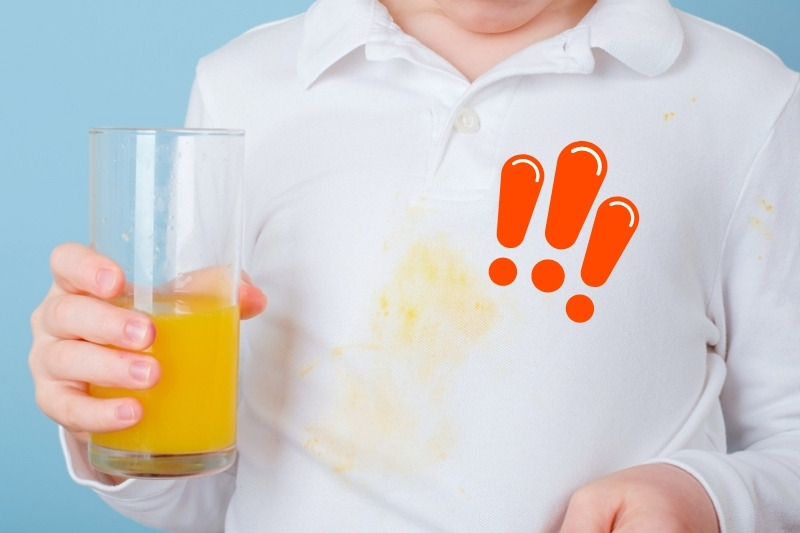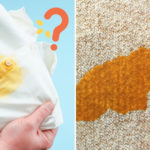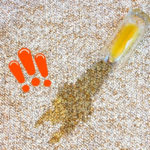If you’ve spilt orange juice on your clothes, you’re probably worried you have ruined them.
The good news is that there are a number of ways to remove orange juice stains from clothes.
Read on to discover the best ways to get orange juice out of clothes.
The methods below are suitable for clothes made from synthetic, cotton and polyester. For information about delicate materials, like wool and silk, jump to the next section.
Method 1: Biological Laundry Detergent
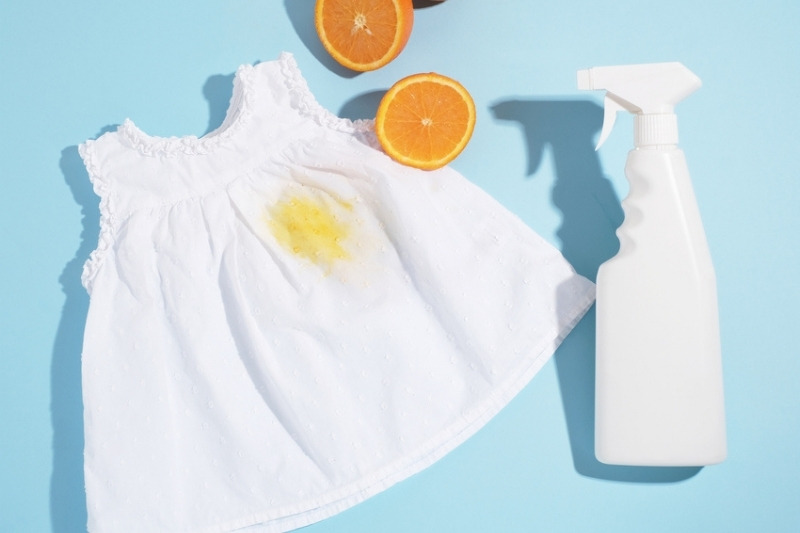
What you need:
- Cloths/towels
- Biological detergent
- Water
- Washing machine (unless you are washing by hand)
Steps to follow:
- Soak up as much orange juice as you can from your garment. Use white towels or cloths to dab at the material.
- Squirt some biological detergent onto the orange juice stain.
- Gently work the detergent into the stain with your fingers or a clean cloth. Massaging the fabric in such a way means that the detergent gets deep down and into the fabric’s fibres. This, in turn, loosens the acidic bond between the juice and the material.
- After a few minutes of massaging, rinse the detergent off your garment and check the stain.
- You probably won’t see much of an orange juice stain on a coloured garment, but on a white item, it will be fairly obvious.
- If you still see a stain, repeat the steps above.
- Launder your garment as normal at the hottest temperature possible—around 40°C would do the trick.
- Have a quick look over the garment before you dry it and treat any stains you see.
- Air dry the garment or pop it into the tumble dryer.
Method 2: Colour-Safe Oxygen Bleach

What you need:
- Cloths
- Bath
- Colour-safe oxygen bleach
- Warm water
- Washing machine (unless you are washing by hand)
- Detergent
Steps to follow:
- As soon as the spillage has taken place, start to blot at the soaked spot on your clothing with a clean, white cloth – avoid using coloured cloths as the dye could transfer onto your clothing.
- Blot up as much orange juice as you can.
- In a tub mix colour-safe oxygen bleach with warm water (follow the guidance on the packaging to pop the correct measure into the bath).
- Put your stained item of clothing in the bath.
- Make sure the item is completely covered by the water (add extra water if need be).
- Leave the item to rest in the water for around four hours, or overnight, if possible.
- Assess the garment for orange juice stains once the time has passed.
- If there are still stains, you will need to repeat the treatment steps above. DO NOT dry the item if there are still stains present—the heat will make the mark tougher to remove.
- If the orange juice stain has gone, you can wash your item as usual in the washing machine – pick the hottest temperature allowed (around 40°C would be fine) and add a strong detergent. See our guide on the best detergents for coloured clothes and white clothes for some recommendations.
- Recheck the item of clothing once again after it has been washed, just to be on the safe side. If it’s clear of stains, you can air dry the garment naturally or use a tumble dryer, if the fabric permits.
Method 3: Chlorine Bleach
For old stains that are on white clothes, you can use chlorine bleach to lift the orange juice mark off the fabric.
For this to work you’ll need to fill a bathtub with warm water and chlorine bleach. Then you’ll need to leave your garment to soak in the water for half an hour to an hour at a time. (You’ll have to check the garment over frequently during this time).
When the stain has gone you can launder the garment. Or if the orange stain remains, you can continue to soak the item in the bleach.
Just remember to thoroughly rinse the garment before laundering it as usual.
Tip: Always do a patch test before you begin, wear gloves, and follow the measurement advice on the bottle of chlorine bleach.
Method 4: Buy a Stain Remover
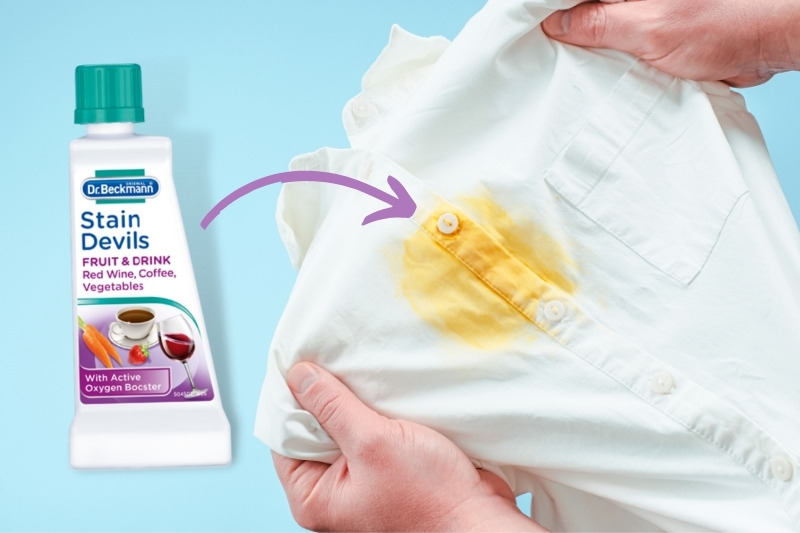
Stain remover products can be a lifesaver when it comes to orange juice stains.
A good option is Dr Beckmann Stain Devils stain remover, which is a powdered formula that can be used to treat several liquid stains. The compact 50g bottle is the ideal item to have at home if you’re prone to treating spills, from wine to fruit juice!
It’s also super easy to use, you just have to wet the garment and sprinkle some of the powder on top of the stain, and within mere minutes you should see significant results.
Method 5: Get Your Clothes Professionally Dry Cleaned
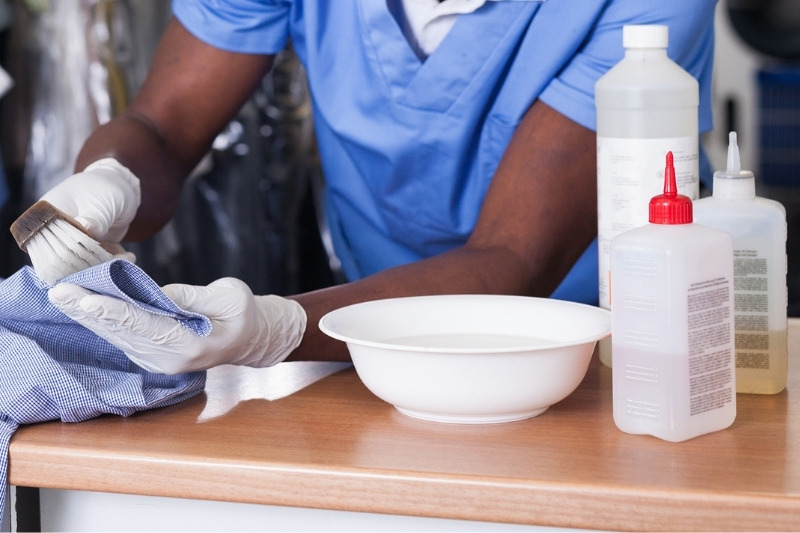
If none of the above methods have worked out, or they’ve not provided you with the end result you wanted, you should look into professional dry-cleaning services.
An online search will bring up businesses in your area, so you can pop down to a store and have a quick chat with an adviser to see what more can be done to save your garment.
Of course, you’ll have to keep in mind that not all items can be dry cleaned, but the person at the dry-cleaning store should be able to advise you further on this matter.
How to Remove Orange Juice Stains from Delicate Materials
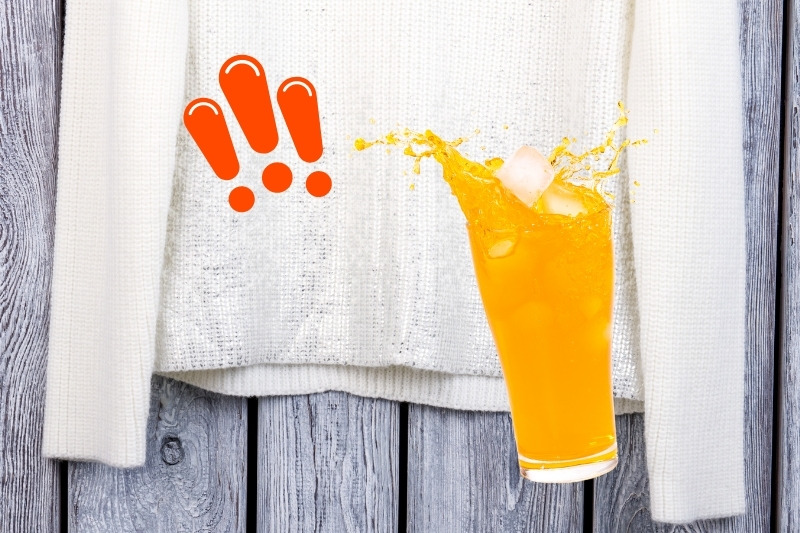
If you’ve got some orange juice-stained delicate materials, like silk or wool, you need to treat these items slightly differently from your cottons, synthetics and polyesters.
To clean these items, you will need to very gently dab at the material to pick up excess liquid, but don’t scrub or carry out this process for very long.
Then you’ll need to put some delicate liquid laundry detergent and warm water in a bowl, and add your orange juice-stained item to the water. The item will need to rest completely submerged in the water for two hours.
You’ll need to check the item after the two-hour period, and if the stain is still present, you can pop the item back into the water. (Leave the item for another hour or so).
When the stain is gone you can launder the item as usual.
Just remember to pick a delicate detergent, like one especially designed for silks, for the treatment listed above. Also, make sure the water you’re using isn’t too hot, because hot water can make delicate materials shrink.

Bethan has a passion for exploring, reading, cooking and gardening! When she’s not creating culinary delights for her family, she’s concocting potions to keep her house clean!
